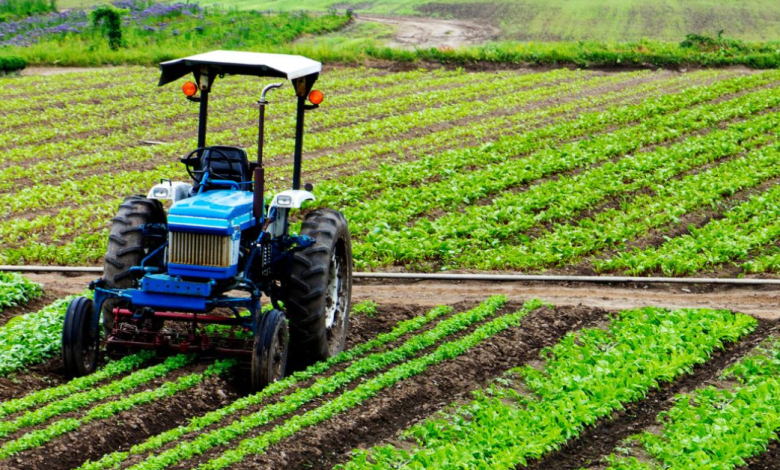
Context- India’s farm sector Gross Value Added (GVA) is likely to see little or no growth in the second half of 2023-24.
Key Highlights
- It cites the weak kharif crop estimates, combined trends in rabi sowing and concerns regarding crop yields.
- The moderate growth in the agriculture, forestry and fishing GVA this fiscal, compared with FY23’s 4% increase, might weigh on rural demand in the close to term.
- It also said that if the coming monsoon turned into regular, sectoral GVA increase can also recover to 3.4% in 2024-25.
Farm sector growth in India
- India is the second biggest producer of farm produce globally, contributing appreciably to the nation wide financial system and rural livelihoods.
- India is the world’s largest producer of milk, pulses and jute, and ranks as the second one largest producer of rice, wheat, sugarcane, groundnut, vegetables, fruit and cotton.
- Recent years have visible modest growth within the agricultural quarter, averaging around 3%.
Recent trends
- The financial Survey 2022-23 stated that the agriculture quarter in the country grew by 3% in 2021-22, decreasing than a mean growth of 4.6% in the remaining six years.
- In 2020-21, the increase in this area was 3.3%. In 2016-17, the increased price was 6.8%, followed by 6.6% in 2017-18, 2.1% in 2018-19 and 5.5% in 2019-20.
- The Survey stated personal investment in agriculture elevated to 9.3% in 2020-21. The public investment, however, remained at 4.3%, the same as 2019-20.
- In 2011-12, the general public investment in agriculture was 5.4%.
Challenges
- Low productivity: Despite being a big producer, India’s farm yields are appreciably lower than global averages due to factors like fragmented landholdings, restrained irrigation, and inadequate adoption of technology.
- Market volatility: Price fluctuations and insufficient marketplace access to make farm incomes volatile, discouraging funding and innovation.
- Climate change: Extreme climate occasions, rising temperatures, and water shortage pose threats to agricultural productivity and farmer livelihoods.
- Post-harvest losses: Lack of proper garage, transportation, and processing infrastructure results in good sized losses, impacting farmer income and food security.
- Rural-urban migration: This creates a scarurban of professional agricultural hard work, in addition hindering productivity growth.
Measures
- Investments in studies and improvement: Focus on excessive-yielding, weather-resilient crop sorts, precision agriculture technology, and advanced irrigation methods.
- Improving market access: Develop and toughen e-trade systems, farmer producer groups (FPOs), and direct advertising and marketing channels to connect farmers to higher markets.
- Investments in rural infrastructure: Build better roads, storage facilities, and cold chains to reduce post-harvest losses and improve market access.
- Climate-clever agriculture: Promote practices like conservation agriculture, water management, and drought-resistant sorts to adapt to weather change.
- Skill development: Train farmers in modern agricultural technology, marketplace cognizance, and financial management to enhance their capabilities.
- Financial inclusion: Ensure smooth entry to credit score and coverage schemes for farmers to invest in their farms and mitigate risks.
- Land reforms: Address troubles like land fragmentation and tenancy regulations to improve land use efficiency and access to sources.
- Promoting diversification: Encourage farmers to undertake allied sports like horticulture, animal husbandry, and aquaculture to supplement their income and decrease dependence on conventional crops.
Government Initiatives
- The Agricultural Technology Management Agency (ATMA) Scheme: Grants-in-useful resources are released with the goal of supporting State Governments’ efforts to have latest agricultural technologies and right agricultural practices in various thematic areas of agriculture and allied sector.
- Krishi UDAN: The scheme proposes help and incentive for the movement of agri-produce by air shipping.
- Pradhan Mantri Kisan Samman Nidhi Yojana (PM-Kisan): An income support of 6,000/- per year in three equal installments could be furnished to all land maintaining farmer households.
- Pradhan Mantri Krishi Sinchai Yojana (PMKSY): Aimed on the improvement of irrigation assets for supplying a permanent solution to drought.
- FDI: The Government of India has allowed 100% FDI in the advertising of food products and in food product E-commerce under the automatic route.
- Kisan Credit Card : Access to institutional credit is being supplied through Kisan Credit Card and other channels.
- E-NAM initiative: Markets across the state are now open to farmers, to allow them to get more remunerative cost for their produce.
- Pradhan Mantri Annadata Aay SanraksHan Abhiyan (PM-AASHA): Ensures Minimum Support Price (MSP) to farmers for diverse Kharif and Rabi crops whilst also maintaining a strong procurement mechanism in place.
- Pradhan Mantri Kisan SAMPADA Yojana (PMKSY): To increase the level of the food- processing industry and encourage rural entrepreneurship throughout the country including rural regions.
- PM Formalization of Micro Food Processing businesss (PMFME) Scheme: Provides financial, technical and commercial business support for putting in place/upgradation of 2 Lakh micro food processing industries through credit linked subsidy.
Way Ahead
- Transforming Indian agriculture requires addressing challenges and leveraging opportunities.
- By making an investment in technology, infrastructure, market access to, and farmer empowerment, India can gain sustainable and inclusive farm sector growth, ensuring food security and rural prosperity.
Source: The Hindu
UPSC Mains Practice Question:
Q.What are the main bottlenecks in upstream and downstream process of marketing of agricultural products in India? (200 words) [2022]
Practice Question:
Q.“The farm sector is essential for India from a consistent growth and food security perspective”. Discuss the steps to be taken to revitalise the farm sector. (250 words)





.png)



